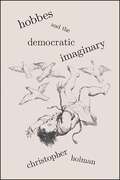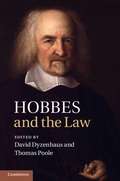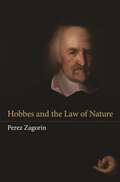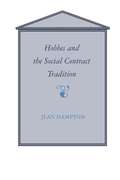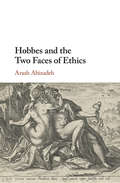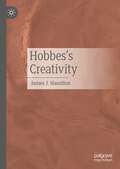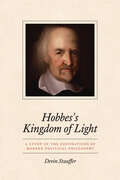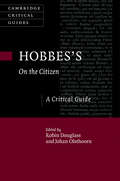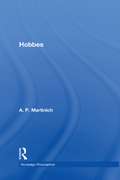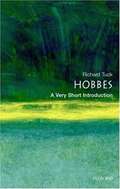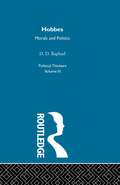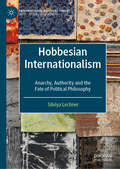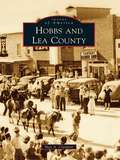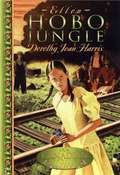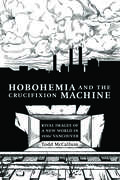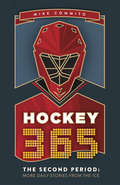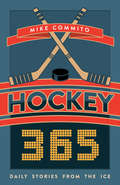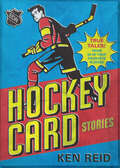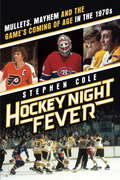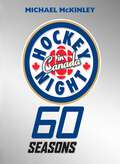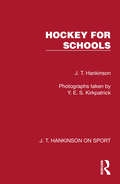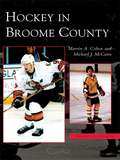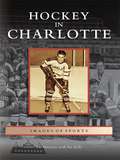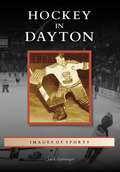- Table View
- List View
Hobbes and the Artifice of Eternity
by Christopher Scott McclureThomas Hobbes argues that the fear of violent death is the most reliable passion on which to found political society. His role in shaping the contemporary view of religion and honor in the West is pivotal, yet his ideas are famously riddled with contradictions. In this breakthrough study, McClure finds evidence that Hobbes' apparent inconsistencies are intentional, part of a sophisticated rhetorical strategy meant to make man more afraid of death than he naturally is. Hobbes subtly undermined two of the most powerful manifestations of man's desire for immortality: the religious belief in an afterlife and the secular desire for eternal fame through honor. McClure argues that Hobbes purposefully stirred up controversy, provoking his adversaries into attacking him and unwittingly spreading his message. This study will appeal to scholars of Hobbes, political theorists, historians of early modern political thought and anyone interested in the genesis of modern Western attitudes toward mortality.
Hobbes and the Democratic Imaginary: Hobbes And The Democratic Imaginary
by Christopher HolmanAt a time when nearly all political actors and observers—despite the nature of their normative commitments—morally appeal to the language of democracy, the particular signification of the term has become obscured. Hobbes and the Democratic Imaginary argues that critical engagement with various elements of the work of Hobbes, a notorious critic of democracy, can deepen our understanding of the problems, stakes, and ethics of democratic life. Firstly, Hobbes's descriptive anatomy of democratic sovereignty reveals what is essential to the institution of this form of government, in the face of the conceptual confusion that characterizes the contemporary deployment of democratic terminology. Secondly, Hobbes's critique of the mechanics of democracy points toward certain fundamental political risks that are internal to its mode of operation. And thirdly, contrary to Hobbes's own intentions, Christopher Holman shows how the selective redeployment of certain Hobbesian categories could help construct a normative ground in which democracy is the ethical choice in relation to other sovereign forms.
Hobbes and the Law
by Thomas Poole David DyzenhausHobbes's political thought provokes a perennial fascination. It has become particularly prominent in recent years, with the surge of scholarly interest evidenced by a number of monographs in political theory and philosophy. At the same time, there has been a turn in legal scholarship towards political theory in a way that engages recognisably Hobbesian themes, for example the relationship between security and liberty. However, there is surprisingly little engagement with Hobbes's views on legal theory in general and on certain legal topics, despite the fact that Hobbes devoted whole works to legal inquiry and gave law a prominent role in his works focused on politics. This volume seeks to remedy this gap by providing the first collection of specially commissioned essays devoted to Hobbes and the law.
Hobbes and the Law of Nature
by Perez ZagorinThis is the first major work in English to explore at length the meaning, context, aims, and vital importance of Thomas Hobbes's concepts of the law of nature and the right of nature. Hobbes remains one of the most challenging and controversial of early modern philosophers, and debates persist about the interpretation of many of his ideas, particularly his views about natural law and natural right. In this book, Perez Zagorin argues that these two concepts are the twin foundations of the entire structure of Hobbes's moral and political thought. Zagorin clears up numerous misconceptions about Hobbes and his relation to earlier natural law thinkers, in particular Hugo Grotius, and he reasserts the often overlooked role of the Hobbesian law of nature as a moral standard from which even sovereign power is not immune. Because Hobbes is commonly thought to be primarily a theorist of sovereignty, political absolutism, and unitary state power, the significance of his moral philosophy is often underestimated and widely assumed to depend entirely on individual self-interest. Zagorin reveals Hobbes's originality as a moral philosopher and his importance as a thinker who subverted and transformed the idea of natural law. Hobbes and the Law of Nature is a major contribution to our understanding of Hobbes's moral, legal, and political philosophy, and a book rich in interpretive and critical insights into Hobbes's writing and thought.
Hobbes and the Social Contract Tradition
by Jean HamptonThis major study of Hobbes' political philosophy draws on recent developments in game and decision theory to explore whether the thrust of the argument in Leviathan, that it is in the interests of the people to create a ruler with absolute power, can be shown to be cogent. Professor Hampton has written a book of vital importance to political philosophers, political and social scientists, and intellectual historians.
Hobbes and the Two Faces of Ethics
by Arash AbizadehReading Hobbes in light of both the history of ethics and the conceptual apparatus developed in recent work on normativity, this book challenges received interpretations of Hobbes and his historical significance. Arash Abizadeh uncovers the fundamental distinction underwriting Hobbes's ethics: between prudential reasons of the good, articulated via natural laws prescribing the means of self-preservation, and reasons of the right or justice, comprising contractual obligations for which we are accountable to others. He shows how Hobbes's distinction marks a watershed in the transition from the ancient Greek to the modern conception of ethics, and demonstrates the relevance of Hobbes's thought to current debates about normativity, reasons, and responsibility. His book will interest Hobbes scholars, historians of ethics, moral philosophers, and political theorists.
Hobbes's Creativity
by James J. HamiltonThis book approaches Hobbes's philosophy from a completely new perspective: his creativity. Creativity is the production of something which experts consider to be original, valuable and of high quality. James Hamilton explores Hobbes's creativity by focusing on his development, personality, and motivation in the context of his culture and environment, and on the ways in which he thought creatively, as inferred from his writings. Identification of the ideas which Hobbes drew upon is an important part of the study for two reasons. First, they are necessary to determine which of Hobbes's ideas and theories are original and which are not. Second, analysis of his creativity requires an understanding of the ideas from which he drew. Hamilton concludes that Hobbes became a great philosopher because of his creative virtuosity.
Hobbes's Kingdom of Light: A Study of the Foundations of Modern Political Philosophy
by Devin StaufferWas Hobbes the first great architect of modern political philosophy? Highly critical of the classical tradition in philosophy, particularly Aristotle, Hobbes thought that he had established a new science of morality and politics. Devin Stauffer here delves into Hobbes’s critique of the classical tradition, making this oft-neglected aspect of the philosopher’s thought the basis of a new, comprehensive interpretation of his political philosophy. In Hobbes’s Kingdom of Light, Stauffer argues that Hobbes was engaged in a struggle on multiple fronts against forces, both philosophic and religious, that he thought had long distorted philosophy and destroyed the prospects of a lasting peace in politics. By exploring the twists and turns of Hobbes’s arguments, not only in his famous Leviathan but throughout his corpus, Stauffer uncovers the details of Hobbes’s critique of an older outlook, rooted in classical philosophy and Christian theology, and reveals the complexity of Hobbes’s war against the “Kingdom of Darkness.” He also describes the key features of the new outlook—the “Kingdom of Light”—that Hobbes sought to put in its place. Hobbes’s venture helped to prepare the way for the later emergence of modern liberalism and modern secularism. Hobbes’s Kingdom of Light is a wide-ranging and ambitious exploration of Hobbes’s thought.
Hobbes's On the Citizen: A Critical Guide (Cambridge Critical Guides)
by Robin Douglass Johan OlsthoornThis is the first book-length study in English of Thomas Hobbes's On the Citizen. It aims to show that On the Citizen is a valuable and distinctive philosophical work in its own right, and not merely a stepping-stone toward the more famous Leviathan. The volume comprises twelve original essays, written by leading Hobbes scholars, which explore the most important themes of the text: Hobbes's accounts of human nature, moral motivation, and political obligation; his theories of property, sovereignty, and the state; and, finally, his ideas on the relation between secular and ecclesiastical authority, and the politics behind his religious ideas. Taken together, the essays bring to light many distinctive aspects of Hobbes's thought that are often concealed by the prevailing focus on Leviathan, making for a richer and more nuanced picture of his moral, legal, and political philosophy.
Hobbes: A Biography (The Routledge Philosophers)
by A.P. MartinichThomas Hobbes (1588-1679) was the first great English philosopher and one of the most important theorists of human nature and politics in the history of Western thought. This superlative introduction presents Hobbes' main doctrines and arguments, covering all of Hobbes' philosophy. A.P. Martinich begins with a helpful overview of Hobbes' life and work, setting his ideas against the political and scientific background of seventeenth-century England. He then introduces and assesses, in clear chapters, Hobbes' contributions to fundamental areas of philosophy: epistemology and metaphysics, in particular Hobbes' materialism and determinism and his relation to Descartes ethics and political philosophy, concentrating on Hobbes' most famous work, Leviathan, and the theory of the social contract it advances philosophy of science, logic and language, considering Hobbes' theory of nominalism and his writing on rhetoric and the uses of language; religion, examining Hobbes' analyses of revelation, prophets and miracles. The final chapter considers the legacy of Hobbes' thought and his influence on contemporary philosophy.
Hobbes: A Very Short Introduction
by Richard TuckThomas Hobbes (1588-1679) was the first great English political philosopher, and his book Leviathan was one of the first truly modern works of philosophy. Richard Tuck shows that while Hobbes may indeed have been an atheist, he was far from pessimistic about human nature, nor did he advocate totalitarianism. By locating him against the context of his age, we learn that Hobbes developed a theory of knowledge which rivaled that of Descartes in its importance for the formation of modern philosophy.
Hobbes: Morals and Politics (Political Thinkers Ser.)
by D D Raphael D. D. RaphaelFirst published in 1977 this book is both expository and critical and concentres on Hobbes' ethical and political theory, but also considering the effect on these of his metaphysics. Updated, with a new preface especially for this re-issue, which brings together recent scholarship on Hobbes, a particular useful feature of the book is the new, critical bibliography.
Hobbesian Internationalism: Anarchy, Authority and the Fate of Political Philosophy (International Political Theory)
by Silviya LechnerThis book sets out to re-examine the foundations of Thomas Hobbes’s political philosophy, and to develop a Hobbesian normative theory of international relations. Its central thesis is that two concepts – anarchy and authority – constitute the core of Hobbes's political philosophy whose aim is to justify the state. The Hobbesian state is a type of authority (juridical, public, coercive, and supreme) which emerges under conditions of anarchy ('state of nature'). A state-of-nature argument makes a difference because it justifies authority without appeal to moral obligation. The book shows that the closest analogue of a Hobbesian authority in international relations is Kant's confederation of free states, where states enjoy 'anarchical' (equal) freedom. At present, this crucial form of freedom is being threatened by economic processes of globalisation, and by the resurgence of private authority across state borders.
Hobbs and Lea County (Images of America)
by Max A. ClampittWhen Lea County was created in 1917 from Eddy and Chaves Counties in the far southeastern corner of New Mexico, it was virtually a blank canvas for new settlers, with few roads, towns, or amenities. At that time, the area was little more than vast pasture lands for cattle, though a handful of hardy folk had already established homesteads in the region. But on June 13, 1928, that all changed when oil was discovered, and almost overnight, an influx of new settlers arrived, and development began in earnest. Oil wells were drilled on ranchers' property, and saloons, stores, and hotels sprang up, especially in the city of Hobbs. The oil boom drove the early economy of Hobbs and Lea County and of southeastern New Mexico, but through boom and bust, the community has endured, and today more than 50,000 residents call it home.
Hobo Jungle: Ellen (Our Candian Girl)
by Dorothy Joan HarrisDuring the Depression in 1939, ten-year-old Ellen misses her life before her father lost his job and her family had to move in with her grandfather in Vancouver.
Hobohemia and the Crucifixion Machine: Rival Images of a New World in 1930s Vancouver
by Todd MccallumIn the early years of the Great Depression, thousands of unemployed homeless transients settled into Vancouver’s “hobo jungle.” The jungle operated as a distinct community, in which goods were exchanged and shared directly, without benefit of currency. The organization of life was immediate and consensual, conducted in the absence of capital accumulation. But as the transients moved from the jungles to the city, they made innumerable demands on Vancouver’s Relief Department, consuming financial resources at a rate that threatened the city with bankruptcy. In response, the municipality instituted a card-control system—no longer offering relief recipients currency to do with as they chose. It also implemented new investigative and assessment procedures, including office spies, to weed out organizational inefficiencies. McCallum argues that, threatened by this “ungovernable society,” Vancouver’s Relief Department employed Fordist management methods that ultimately stripped the transients of their individuality. Vancouver’s municipal government entered into contractual relationships with dozens of private businesses, tendering bids for meals in much the same fashion as for printing jobs and construction projects. As a result, entrepreneurs clamoured to get their share of the state spending. With the emergence of work relief camps, the provincial government harnessed the only currency that homeless men possessed: their muscle. This new form of unfree labour aided the province in developing its tourist driven “image” economy, as well as facilitating the transportation of natural resources and manufactured goods. It also led eventually to the most significant protest movement of 1930s’ Canada, the On-to-Ottawa Trek. Hobohemia and the Crucifixion Machine explores the connections between the history of transiency and that of Fordism, offering a new interpretation of the economic and political crises that wracked Canada in the early years of the Great Depression.
Hockey 365, The Second Period: More Daily Stories from the Ice
by Mike CommitoMore hockey history for every day of the year! Celebrate hockey history with Hockey 365, The Second Period and be reminded of why you love hockey every day of the year. Whether you are a long-suffering Leafs fan or you cheer for a team that has actually won a Stanley Cup in the last half-century, this compendium will give you a hockey-history fix no matter your allegiance. From the National Hockey League’s humble beginnings to the empty seats of the 2020 Stanley Cup Playoffs, Mike Commito has gone back into the vault to bring you even more hockey history. So, get ready, the second period is about to begin.
Hockey 365: Daily Stories from the Ice
by Mike CommitoA hockey history moment for every day of the year! A few seconds can make a game, even a season, and behind each play is a piece of history. Mike Commito marks every day of the year with a great moment in hockey and shows how today's game is part of an ongoing story that dates back to its origins on frozen ponds. From the National hockey League’s first games in 1917 to Auston Matthews's electrifying four-goal debut for the Maple Leafs in 2016, Hockey 365 has something for everyone and is sure to give you a better appreciation for the sport we all love.
Hockey Card Stories: True Tales! From 59 of Your Favourite Players (Hockey Card Stories)
by Ken Reid&“Nobody enjoys the full kaleidoscope of the game quite like Kenny, from banana blades and &’70s staches to air-brushed, mistake-laden hockey cards.&” —Jeff Marek, Sportsnet Hockey host and Marek vs. Wyshynski podcast co-host Hockey Card Stories reveals what was really going on in your favorite old hockey cards through the eyes of the players depicted on them. Some of the cards are definitely worth a few bucks, some a few cents—but every story told here is priceless. Sportsnet&’s Ken Reid presents the cards you loved and the airbrushed monstrosities that made you howl, the cards that have been packed away in boxes forever, and others you can&’t believe ever existed. Whether it&’s a case of mistaken identity or simply a great old photo, a fantastic 1970s haircut and &’stache, a wicked awesome goalie mask or a future Hall of Famer&’s off-season fashion sense, a wide variety of players—from superstars like Bobby Orr, Denis Potvin, and Phil Esposito to the likes of Bill Armstrong who played only one game in the NHL—chime in on one of their most famous cards. &“Hockey Card Stories is a sports fan&’s dream—humorous, detailed and nostalgic. I hope there&’s more where this came from.&” —Terry Ryan, author of Tales of a First-Round Nothing &“Bright, funny and filled with a real love of the sport and a genuine affection for its great characters.&” —Stephen Brunt, author of Searching for Bobby Orr and Prime Time Sports cohost &“When Ken is passionate about a topic, he&’s the most knowledgeable individual in the room . . . in this book, you&’ll quickly appreciate his passion for hockey cards . . . What a nerd.&” —Evanka Osmak, Sportsnet Connected co-anchor
Hockey Night Fever
by Stephen ColeA wildly evocative chronicle of the decade that changed hockey forever. "Lady Byng died in Boston" read a sign in the Garden arena in 1970, a cheery dismissal of the NHL trophy awarded the game's most gentlemanly player. A new age of hockey was dawning. For 30 years, hockey was an orderly and (relatively) well-behaved sport. There was one Commissioner, six teams and five colours--red, white, black, blue and yellow. Oh, and one nationality. Until 1967, every player, coach, referee and GM in the NHL had been a Canadian. And then came NHL expansion, the founding of the WHA, and garish new uniforms. The Seventies had arrived: the era that gave us not only disco, polyester suits, lava lamps and mullets but also the movie Slap Shot and the arrest of ten NHL players for on-ice mayhem. But it also gave us hockey's greatest encounter (the 1972 Canada-Russia Summit), its most splendid team, the 1976-77 Montreal Canadiens, and the most aesthetically satisfying game--the three-all tie on New Year's Eve, 1975, between the Canadiens and the Soviet Red Army. Modern hockey was born in the sport's wild, sensational, sometimes ugly Seventies growth spurt. The forces at play in the decade's battle for hockey supremacy--dazzling speed vs. brute force--are now, for better or worse, part of hockey's DNA. This book is a welcome reappraisal of the ten years that changed how the sport was played and experienced. Informed by first-hand interviews with players and game officials, and sprinkled with sidebars on the art and artifacts that defined Seventies hockey, the book brings dramatically alive hockey's most eventful, exciting decade.
Hockey Night In Canada: 60 Seasons
by Michael MckinleyHockey Night in Canada has reached a great age (and for television, practically an immortal one) because it made itself into something that Canada couldn't live without. It is this surge of emotion that connected us all each week, and which connects us through the years to now. Hockey Night in Canada didn't just aim a camera at a game and observe what happened-it actively gave the country a prism through which it could see itself and its evolving diversity. We look where the eye of Hockey Night in Canada looks, and it looks at us. We remember what it remembers. We feel what it feels. That is the dynamic that has made the show much more than a long-lived TV success; it is a cultural juggernaut. Ask fans where they saw their first hockey game, and chances are it was on Hockey Night in Canada. Ask the players-male or female-what first got them into the rink, and the answer will be the same: they wanted to be like the players on Hockey Night in Canada.
Hockey for Schools (J. T. Hankinson on Sport)
by J. T. HankinsonOriginally published in 1947, this book, the third of the series, deals with hockey coaching and practice in schools. It was produced in a School, and once again the action photographs are of boys who were at that time in the School Team. The author had considerable experience in the coaching of school hockey.The book opens with descriptions of the basic arts: hitting, gathering, dribbling, tackling etc., required of all players, after which the play and tactics of each position on the field are analysed. A specially interesting chapter is that on team tactics and positional play, and this chapter is illustrated by some excellent photographs of a tactical table, in which the dispositions in various situations are diagrammatically set out. Other chapters deal with captaincy, coaching, school organization, how to watch a match, and some explanatory comments on the rules of the game.The book is illustrated by many magnificent action photographs. While this book was primarily for schools, the instructional detail and the attractiveness of the photographs would also have appealed to more mature hockey players. Today it can be enjoyed in its historical context.
Hockey in Broome County (Images of Sports)
by Marvin A. Cohen Michael J. MccannThe Broome Dusters played their first home game at the Broome County Veterans Memorial Arena on October 18, 1973. The game was symbolic of what was to come. Down 6-0, they fought back only to lose 8-7. Their fan support followed a similar pattern, lukewarm at first and then ferociously loyal. Hockey became a passion for local fans and has continued to be so to this day. When the Dusters disbanded, they were followed by the Whalers, Rangers, B.C. Iceman, and the Senators. Hockey in Broome County tells this fascinating story with more than 200 photographs and engaging text. Relive the heroics of the Dusters' Rod Bloomfield, "the little guy that everyone picked on." Then skip ahead to the crowd-pleasing toughness of the Whalers' Randy MacGregor and the more recent brilliance of the Senators' Jason Spezza.
Hockey in Charlotte (Images of Sports)
by Jim Mancuso Pat KellyCharlotte is considered the birthplace of professional hockey in the South. The city of Charlotte, home of the Checkers (originally known as the Clippers), is the greatest Southern town in the history of professional hockey, winning the most play-off championships: three Eastern Hockey League titles, two Southern Hockey League titles, and one East Coast Hockey League title. Several Charlotte players and coaches starred in the National Hockey League--including Walter "Turk" Broda, John Brophy, Fred Creighton, Bill "Cowboy" Flett, Mike Hartman, Pat Kelly, Jackie Leclair, and John Muckler.
Hockey in Dayton (Images of Sports)
by Chuck GabringerIn the 1950s, crowds that equaled half the city of Troy's population filled the newly constructed 3,900-seat Hobart Arena to watch the area's first hockey team, the Troy Bruins, take the ice. In the 1960s and 1970s, fans packed one of hockey's great "barns," Hara Arena, to watch the Dayton Gems become one of the more well-known and successful franchises in all of professional hockey. In the 1990s and 2000s, it was the Dayton Bombers that reignited the area's love for hockey. Hockey in Dayton tells the story of the teams, players, people, and events that have permanently frozen hockey's place in the history of Dayton area sports.

